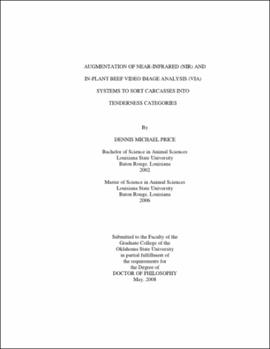| dc.contributor.advisor | Morgan, Brad | |
| dc.contributor.author | Price, Dennis Michael | |
| dc.date.accessioned | 2013-11-26T08:22:38Z | |
| dc.date.available | 2013-11-26T08:22:38Z | |
| dc.date.issued | 2008-05 | |
| dc.identifier.uri | https://hdl.handle.net/11244/6617 | |
| dc.description.abstract | Scope and Method of Study: Near-infrared (NIR) spectroscopy and video image analysis (VIA) are useful tools that can provide information about quality, yield, and tenderness of beef carcasses. The objectives of this study were to determine the combined effect of NIR and VIA on the effectiveness of predicting 7-d and 14-d tenderness of ribeye samples in various quality grades, observe the relationship between predicted ribeye shear force and tenderness of short-term muscles, and obtain consumer perceptions of ribeye steaks that were categorized as "tender", "intermediate", or "tough". Beef carcasses (Phase I, n = 51; Phase II, n = 191; Phase III, n = 191) were selected (d-2) from a commercial beef processing facility. Ribeye sections were scanned with VIA and NIR cameras following carcass presentation to in-plant USDA grading personnel. Subprimals (ribeye, Phases I & II; ribeye, clod, top sirloin, and inside round, Phase III) were fabricated from each carcass and transported to OSU. Steaks were fabricated (d-3), then individually vacuum packaged and aged at 4C for 7-d or 14-d prior to cooking and Warner-Bratzler and slice shear force analysis. Wavelength coefficients were generated from NIR spectral data and used with VIA and SSF data for statistical analysis by regression to predict 7-d and 14-d steak tenderness. Consumer panelists (n = 200) were asked to evaluate the tenderness, juiciness, and flavor of three steaks from tender (< 19 kg), intermediate (19-25 kg), and tough (> 25 kg) categories. The regression equations were significant (Phase I, R2 = 0.90; Phase III, R2 = 0.82) for 7-d and (Phase I, R2 = 0.91; Phase II, R2 = 0.80; Phase III, R2 = 0.65) 14-d tenderness prediction. | |
| dc.description.abstract | Findings and Conclusions: The regression equation generated from ribeye NIR and VIA data was not successful in predicting the tenderness of additional subprimals (P > 0.05). In Phase III, consumers were able to detect differences in tenderness, juiciness, and flavor between tender, intermediate, and tough classified steaks (P < 0.05). Consumers were willing to pay premium prices for pre-identified tender (63.9%) and intermediate (64.7%) steaks. Scanning beef carcasses with NIR and VIA cameras were very accurate at sorting carcasses into tenderness groups. | |
| dc.format | application/pdf | |
| dc.language | en_US | |
| dc.rights | Copyright is held by the author who has granted the Oklahoma State University Library the non-exclusive right to share this material in its institutional repository. Contact Digital Library Services at lib-dls@okstate.edu or 405-744-9161 for the permission policy on the use, reproduction or distribution of this material. | |
| dc.title | Augmentation of near-infrared (NIR) and in-plant beef video image analysis (VIA) systems to sort carcasses into tenderness categories | |
| dc.contributor.committeeMember | VanOverbeke, Deborah L. | |
| dc.contributor.committeeMember | DeWitt, Christina | |
| dc.contributor.committeeMember | Step, Douglas L. | |
| osu.filename | Price_okstate_0664D_2652 | |
| osu.accesstype | Open Access | |
| dc.type.genre | Dissertation | |
| dc.type.material | Text | |
| dc.subject.keywords | beef | |
| dc.subject.keywords | near-infrared | |
| dc.subject.keywords | tenderness prediction | |
| thesis.degree.discipline | Food Science | |
| thesis.degree.grantor | Oklahoma State University | |
